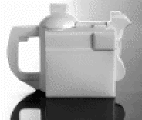|
In the highly developed artistic climate of Moscow
and St Petersburg before the revolution Malevich joined up with
the avantgarde and assimilated the international influence of
Expressionism and Cubism into his scenes of peasant life. At
the age of 29 he participated in an exhibition with Kandinsky.
Five years later, in 1912, the Donkey’s Tail group juxtaposed
work by Malevich and Tatlin. In 1913 he rebelled, attacking
old friends in art; with the composer Matyushin he created theatrical
performances of literary works by Mayakovsky and Khlebnikov.
He designed costumes for the opera Victory over the Sun
and in 1914 he defended Marinetti in his visit to Moscow. But
it is his creation of Suprematism – the supremacy of an experience
evoked by pure visual art – which still resounds. At the end
of 1915 he confronted the world with a sensational visual fact
divorced from all links with recognisable manifestations – a
black square on a white background.
An investigation into the
field of painterly culture is the modest title given to a set
of 22 large charts, which are the concise record of research
into the content and development of modern painting produced
under the aegis of Malevich at the State Institute of Artistic
Culture in Leningrad, when he headed the Formal Theoretical
Department. According to the general guidelines of the department,
set up in 1923, its task was the formal analysis of paintings
in accordance with a perpetually changing Weltempfant
or reception of the world. Malevich regarded works which involved
this process as living organisms, in contrast to paintings in
which narrative or aesthetic grounds govern the artist. Tarkovsky,
nearer to our own time, has discussed a similar division between
film directors who allow the world to acquire form through the
poet’s personal vision (Bergman, Kurosawa and Tarkovsky
himself) and those who make the literal translation of a screenplay,
for whom the narrative is dominant.
Remarkably, the charts are annotated in German,
a language that Malevich did not speak. On nearly every one,
in an inconspicuous position, is a small handwritten Russian
text, an approximate translation from the German. When his reputation
in Western Europe grew, Malevich accompanied a major exhibition
of his work to Warsaw and Berlin. The charts were essential
to the general purpose of the journey to inform the Western
public about Suprematism. Today they pose several problems.
The lecture they illustrated, which evidently elicited an enthusiastic
response, has been lost. All that remains are the 22 numbered
charts which even Malevich admitted were almost incomprehensible
(with or without a lecture). The concurrent Berlin exhibition
in 1927 presented a survey of Malevich’s development as
a painter and designer, but isolated from the theoretical context
which he valued so highly. The charts are a vital part of Malevich’s
work for they convey an explicit idea of his views on art.
It could follow that every trend in contemporary
art establishes its own prism and that each prism, although
positioned at a different viewpoint, resembles the one next
to it. This idea could be extended to mean therefore that there
are no real opposing judgments of contemporary art. Malevich’s
own judgments on his contemporaries remain misunderstood. He
was unsympathetic to the narrative art of his period if it also
suggested discovery, although he failed to recognise the focus
of his complaint. He regarded Futurism as an imitative art for
example, but did not mention the aesthetic or narrative considerations
in Futurist paintings for which he had clear disdain.
The second group of charts analyses perception.
From them Malevich’s classification of painting becomes
clear at a glance: art at the service of literature and non-objective ‘art
as such’. A reproduction of a painting by Boccioni is
ruthlessly termed classical and naturalistic art.
The third section of charts
illustrates a new teaching method. According to Malevich, a
student was not urged to work as a suprematist. Instead a variety
of questions and assignments would deduce his sensations and
stage of development in a chosen style. One student was ‘diagnosed’
a painterly realist, which meant that he entertained realistic
notions about painting itself. At the time of the investigation
the student was using both cubist and suprematist stylistic
features. His work was eclectic and called for didactic intervention.
As a result of conversations and tasks, the student started
working in an early cubist style until, according to a graph
in the chart, he came in perfect contact with his work and consequently
satisfied.
After Berlin, Malevich entrusted many works from
his exhibition to a German friend who was unable to make them
productive in an era of growing Nazism. On his return to Russia,
Malevich faced a new cultural policy which was uninterested
in his formalism. He looked back to his point of departure before
1913 as the ‘New Russian Style’. The work that ensued
was remarkable for its figurative character but no less for
the power which it expressed. Was he trying to teach his compatriots
what real socialist, realistic art was or should be? Or, even
better, what the art is of a socialist society focused on the
common person?
There is no answer. A silence fell which, despite
the unavailability of most of his work after his death in 1935,
fortunately did not condemn him to oblivion. The paradox of
denial is so eminently the theme of Russia, and Russia’s
denied idealistic socialism seems emblematic of the artistic
dilemma of our lives. The theme’s most poignant manifestation
is in the featureless peasant figures. They symbolise a general
irony, for they appear trusting in their candour. Feet are placed
firmly on the ground; the vibrant colours cherish optimism.
Now that modern Russia has decided to endorse the imagery created
during the Revolutionary period, the importance of Malevich’s
work has been underlined.
A Review of the Malevich
exhibition at the Stedelich Museum, Amsterdam in 1989. First
published in Art Monthly UK and Art Monthly Australia in 1989
Timothy Foster
|
 |